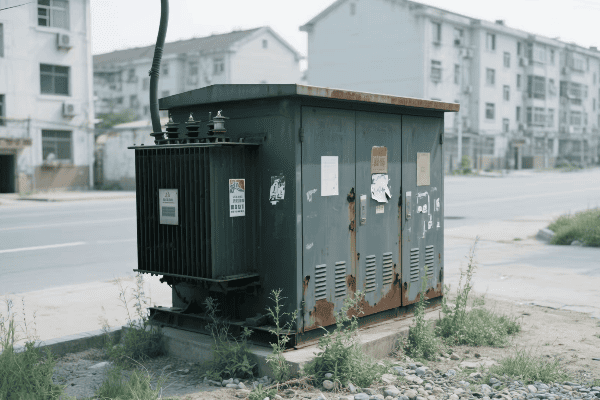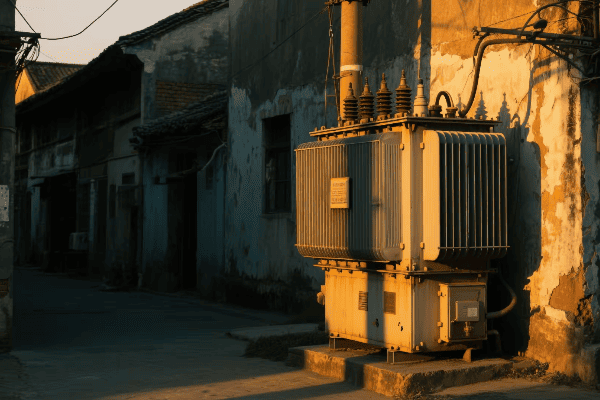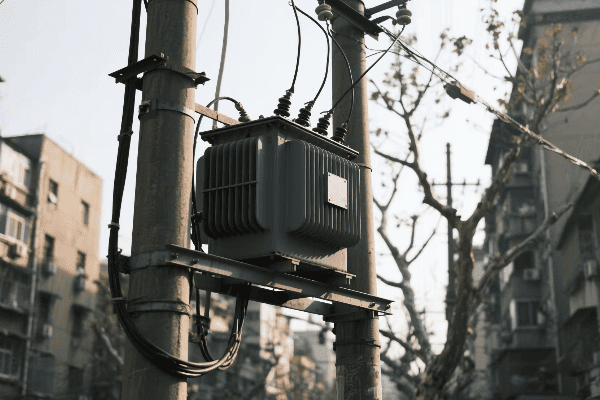Dry Type Distribution Transformer: Revolutionizing Urban Power Infrastructure?
Are you tired of bulky, noisy transformers in your city? Dry type distribution transformers are here to change the game, offering a sleek solution to urban power needs.
Dry type distribution transformers are revolutionizing urban power infrastructure by providing compact, safe, and efficient power distribution solutions. These transformers address the unique challenges of high-density urban areas, enhancing reliability and supporting smart city initiatives.

As someone who’s worked in the power industry for years, I’ve seen firsthand how dry type transformers are transforming our cities. Let’s explore how these innovative devices are reshaping urban power landscapes and why they’re becoming the go-to choice for modern city planners and engineers.
Space-Efficient Solutions: Dry Type Transformers in High-Density Urban Areas?
Ever wondered how cities manage to power skyscrapers without massive transformer yards? The answer lies in the compact design of dry type transformers.
Dry type transformers offer space-efficient solutions for high-density urban areas by eliminating the need for oil-filled tanks and fire-suppression systems. Their compact design allows for installation in confined spaces, making them ideal for high-rise buildings and underground substations.

Let’s dive deeper into how these transformers are maximizing space in our crowded cities:
Vertical Integration
Powering up, not out:
- Installation in high-rise mechanical rooms
- Stacked configurations for multi-floor power distribution
- Reduced footprint compared to traditional oil-filled units
Underground Solutions
Hiding power beneath our feet:
- Vault-type installations in underground parking areas
- Subway station power distribution centers
- Seamless integration with underground utility corridors
Modular Designs
Flexibility for growing urban needs:
- Scalable units for expanding power requirements
- Easy installation and replacement in tight spaces
- Customizable configurations for unique urban layouts
| Feature | Space-Saving Benefit | Urban Application |
|---|---|---|
| Compact Size | Up to 50% smaller footprint | High-rise buildings |
| Vertical Design | Utilizes vertical space | Multi-story installations |
| Modular Units | Flexible expansion | Growing urban developments |
I remember a project where we replaced an old oil-filled transformer with a dry type unit in a downtown office building. The building manager was amazed. "We’ve just gained an entire storage room," he said. "I never thought a transformer upgrade could give us more usable space."
Another eye-opening experience was in a new smart city development. We installed compact dry type transformers in underground vaults throughout the district. A city planner remarked, "These transformers have allowed us to create more green spaces above ground. It’s a win for both infrastructure and livability."
These experiences highlight how dry type transformers are not just about power distribution; they’re about smart urban design. By minimizing the space needed for electrical infrastructure, these transformers are helping cities maximize land use efficiency. This is crucial in urban areas where every square foot counts.
As cities continue to grow vertically and densify, the demand for space-efficient power solutions will only increase. Dry type transformers are well-positioned to meet this need, offering a perfect blend of performance and compact design. Their ability to fit into tight spaces without compromising on power capacity makes them an invaluable tool in the urban planner’s arsenal.
Enhanced Safety and Reliability: The Urban Advantage of Dry Type Distribution Transformers?
Worried about fire hazards in densely populated areas? Dry type transformers offer a safer alternative that’s changing the game in urban power distribution.
Dry type distribution transformers enhance urban safety and reliability through their fire-resistant design and reduced maintenance needs. These features make them ideal for installation in buildings, reducing the risk of fire and oil spills while ensuring consistent power supply in critical urban environments.

Let’s explore how these transformers are making our cities safer and more reliable:
Fire Safety Advantages
Minimizing urban fire risks:
- Non-flammable insulation materials
- Elimination of combustible oil
- Reduced need for extensive fire suppression systems
Environmental Protection
Keeping cities clean and green:
- No risk of oil leaks or spills
- Easier compliance with environmental regulations
- Reduced soil and water contamination risks
Reliability in Harsh Conditions
Powering through urban challenges:
- Resistance to moisture and dust
- Ability to operate in high-pollution environments
- Consistent performance in varying temperatures
| Safety Feature | Urban Benefit | Reliability Impact |
|---|---|---|
| Fire Resistance | Reduced fire risk in buildings | Fewer power interruptions due to fire incidents |
| No Oil | Eliminated spill hazards | Lower environmental impact and cleanup costs |
| Sealed Design | Protection from urban pollutants | Increased lifespan and reduced maintenance |
I once worked on a project replacing oil-filled transformers in a hospital with dry type units. The facility manager was initially skeptical about the change. After the installation, he told me, "I sleep better at night knowing we’ve reduced our fire risk. In a hospital, reliable power isn’t just convenient; it’s life-saving."
Another memorable experience was in a coastal city prone to flooding. We installed dry type transformers in a low-lying business district. During a severe storm that flooded part of the area, these transformers continued to operate safely. A local business owner said, "While other parts of the city went dark, our lights stayed on. It’s incredible how these transformers can withstand such conditions."
These experiences underscore the critical role of dry type transformers in enhancing urban safety and reliability. They’re not just electrical components; they’re guardians of our cities’ power infrastructure. By reducing fire risks and environmental hazards, these transformers are making our urban spaces safer for everyone.
The reliability of dry type transformers in harsh urban conditions is equally impressive. Their sealed design protects them from the dust, pollution, and moisture that are common in city environments. This means fewer breakdowns, less maintenance, and more consistent power supply – crucial factors in keeping our cities running smoothly.
As urban populations continue to grow and cities become more densely packed, the safety and reliability advantages of dry type transformers will become even more critical. They represent a significant step forward in creating resilient, safe, and efficient urban power networks.
Smart City Integration: Dry Type Transformers as Enablers of Intelligent Power Grids?
Ever wondered how smart cities manage their complex power needs? Dry type transformers are playing a crucial role in enabling intelligent power grids for our urban future.
Dry type transformers are key enablers of smart city power grids, offering advanced monitoring capabilities, easy integration with digital systems, and support for renewable energy sources. These features allow for real-time power management, predictive maintenance, and efficient energy distribution in intelligent urban environments.

Let’s delve into how these transformers are powering the smart cities of tomorrow:
Advanced Monitoring Systems
Keeping a pulse on urban power:
- Real-time data collection on power quality and usage
- Integration with smart grid management platforms
- Early detection of potential issues for proactive maintenance
Renewable Energy Integration
Supporting green urban power:
- Compatibility with solar and wind power systems
- Efficient handling of bidirectional power flow
- Voltage regulation for variable renewable inputs
Load Management and Demand Response
Balancing urban power needs:
- Dynamic load balancing capabilities
- Support for peak shaving and load shifting
- Integration with smart building energy management systems
| Smart Feature | Urban Benefit | Grid Integration Impact |
|---|---|---|
| Real-time Monitoring | Improved power reliability | Enhanced grid responsiveness |
| Renewable Compatibility | Increased green energy adoption | Smoother integration of distributed resources |
| Load Management | Optimized energy distribution | Reduced strain on urban power infrastructure |
I remember a project where we installed smart dry type transformers in a new urban development. The city’s energy manager was amazed by the level of control and insight they gained. "It’s like having a crystal ball for our power grid," he said. "We can predict and prevent issues before they happen, keeping our city running smoothly."
Another fascinating experience was in a smart city pilot program. We integrated dry type transformers with a citywide IoT network. During a heatwave, the system automatically adjusted power distribution to prevent overloads. A grid operator told me, "These transformers aren’t just distributing power; they’re actively managing our entire energy ecosystem."
These experiences highlight how dry type transformers are not just passive components in smart cities; they’re active participants in creating more intelligent and responsive urban environments. Their ability to provide real-time data and respond to changing power needs makes them invaluable in the complex dance of urban energy management.
The integration of these transformers with renewable energy sources is particularly exciting. As cities strive to reduce their carbon footprint, dry type transformers are making it easier to incorporate solar panels, wind turbines, and other green energy sources into the urban power mix. Their ability to handle the variable nature of renewable energy is crucial in building sustainable city power grids.
Looking ahead, the role of dry type transformers in smart cities will likely expand even further. We might see them becoming even more integrated with AI-driven grid management systems, playing a key role in optimizing energy use across entire urban areas. The future of urban power is smart, and dry type transformers are at the heart of this revolution.
Sustainable Urban Development: The Role of Dry Type Transformers in Green City Initiatives?
Curious about how cities are becoming greener? Dry type transformers are playing a surprising role in sustainable urban development, contributing to eco-friendly city initiatives in ways you might not expect.
Dry type transformers contribute significantly to green city initiatives by reducing environmental impact, supporting energy efficiency, and facilitating the integration of renewable energy sources. Their eco-friendly design and operation align perfectly with sustainable urban development goals.

Let’s explore how these transformers are helping to build greener cities:
Eco-Friendly Materials and Design
Minimizing environmental footprint:
- Use of recyclable and biodegradable materials
- Reduced use of harmful substances like oil and SF6 gas
- Compact design requiring less raw material
Energy Efficiency
Cutting urban power losses:
- High efficiency ratings reducing energy waste
- Lower no-load losses compared to oil-filled transformers
- Optimized performance in partial load conditions common in urban settings
Support for Renewable Energy
Enabling green power integration:
- Compatibility with solar and wind power systems
- Efficient handling of distributed energy resources
- Voltage regulation capabilities for intermittent renewable sources
| Green Feature | Urban Sustainability Impact | Environmental Benefit |
|---|---|---|
| Eco-Materials | Reduced waste and pollution | Lower carbon footprint in production and disposal |
| High Efficiency | Decreased energy consumption | Reduced greenhouse gas emissions from power generation |
| Renewable Support | Increased clean energy adoption | Lowered dependence on fossil fuels |
I recall a project where we replaced old transformers with high-efficiency dry type units in a large urban office complex. The building’s energy consumption dropped significantly. The facility manager was ecstatic, saying, "We’ve cut our energy bills by 15%, and our carbon footprint is way down. It’s a win-win for our bottom line and the environment."
Another memorable experience was in a new eco-friendly residential development. We installed dry type transformers that were perfectly suited for the community’s rooftop solar installations. A resident told me, "It’s amazing to see how these transformers help us use more of the solar power we generate. We feel like we’re really contributing to a greener future."
These experiences underscore the crucial role of dry type transformers in sustainable urban development. They’re not just power distribution devices; they’re key components in the broader ecosystem of green city initiatives. By reducing energy waste, supporting renewable integration, and minimizing environmental impact, these transformers are helping cities meet their sustainability goals.
The eco-friendly design of dry type transformers also aligns well with green building certifications like LEED. Their energy efficiency and reduced environmental impact can contribute valuable points to these certifications, encouraging more sustainable construction practices across urban areas.
As cities continue to focus on sustainability and climate resilience, the importance of green infrastructure like dry type transformers will only grow. They represent a tangible way for urban areas to reduce their environmental impact while maintaining the reliable power supply necessary for modern city life. The future of urban development is green, and dry type transformers are helping to power this sustainable revolution.
Urban Maintenance Revolution: Simplifying Power Infrastructure Upkeep with Dry Type Technology?
Ever wondered how cities keep their power flowing without constant disruptions? Dry type transformers are revolutionizing urban maintenance, making power infrastructure upkeep simpler and more efficient than ever before.
Dry type transformers are simplifying urban power infrastructure maintenance through their low-maintenance design, easy monitoring capabilities, and reduced need for specialized handling. This technology is revolutionizing how cities manage and maintain their electrical systems, leading to more reliable power and lower operational costs.

Let’s dive into how these transformers are changing the game in urban maintenance:
Reduced Maintenance Requirements
Keeping the lights on with less effort:
- No oil to monitor, test, or replace
- Fewer moving parts prone to wear and tear
- Longer intervals between routine maintenance checks
Easy Monitoring and Diagnostics
Staying ahead of potential issues:
- Built-in sensors for real-time performance monitoring
- Integration with smart grid systems for remote diagnostics
- Predictive maintenance capabilities using data analytics
Simplified Installation and Replacement
Minimizing urban disruptions:
- Lighter weight for easier transportation and installation
- No need for oil containment structures
- Plug-and-play designs for quick replacements
| Maintenance Aspect | Urban Benefit | Operational Impact |
|---|---|---|
| Oil-Free Design | No oil handling or disposal | Reduced environmental risks and costs |
| Remote Monitoring | Less frequent on-site visits | Improved response times to potential issues |
| Easy Installation | Quicker setup and replacement | Minimized power disruptions during upgrades |
I remember a project where we upgraded an entire district’s worth of transformers to dry type units. The city’s maintenance team was initially skeptical about the change. Six months later, the lead technician told me, "We’ve cut our maintenance rounds by half, and we haven’t had a single unexpected outage. These transformers are a maintenance dream."
Another eye-opening experience was in a busy commercial area where transformer replacements used to cause significant disruptions. We installed modular dry type units that could be swapped out quickly. During an emergency replacement, a shop owner remarked, "I can’t believe how fast they changed that transformer. In the past, we’d be closed for days. This time, we barely noticed."
These experiences highlight how dry type transformers are not just improving power distribution; they’re revolutionizing how cities approach infrastructure maintenance. The reduction in routine maintenance needs frees up resources that can be redirected to other critical urban services. It’s not just about saving time and money; it’s about creating more resilient and efficiently managed cities.
The ability to monitor these transformers remotely and predict potential issues before they occur is particularly game-changing. It allows cities to shift from reactive to proactive maintenance strategies, preventing outages rather than just responding to them. This predictive approach is crucial in modern urban environments where reliable power is essential for everything from traffic management to emergency services.
As cities continue to grow and evolve, the maintenance advantages of dry type transformers will become even more valuable. They represent a shift towards smarter, more efficient urban infrastructure management. By simplifying maintenance and improving reliability, these transformers are helping to build cities that are not just powered, but empowered to meet the challenges of the future.
Conclusion
Dry type distribution transformers are revolutionizing urban power infrastructure through space-efficient designs, enhanced safety, smart grid integration, sustainability features, and simplified maintenance. They are key enablers of modern, efficient, and resilient city power systems.
Free CHBEB Transformer Catalog Download
Get the full range of CHBEB transformers in one catalog.
Includes oil-immersed, dry-type, pad-mounted, and custom solutions.
Quick Message
Request A free quote
We'd like to work with you
- +86 15558785111
- [email protected]
- +86 15558785111
What We Do
CHINA BEI ER BIAN (CHBEB) GROUP, with 218 million in registered capital, originated from Beijing Beierbian Transformer Group. Headquartered in Beijing for R&D, it operates major production bases in Nanjing and Yueqing, producing high-quality products.
Latest Product
address
BeiJing
No 3,RongJing East Road,BeiJing Economic Technological Development Area,BeiJing,China
JiangSu
No 7️Xiangfeng Road,Jiangning,NanJing,JiangSu,China
WenZhou
No.211, Wei 16 Road, Industrial Zone, Yueqing, Wenzhou, Zhejiang, China.
XiangYang Industrial Zone ,YueQing,WenZhou,ZheJiang,China
contact us
- [email protected]
- +86 13057780111
- +86 13057780111
- +86 15558785111
Copyright © Bei Er Bian Group


